|
|
Print this review
Nvidia runs with Windows Mobile
NVidia enjoys great renown for its graphics cards for desktop PCs, but the average consumer knows nothing of its affairs in the field of mobile devices. However, having a slew of graphics-centric technologies under its belt, it didn’t want to shun from the booming mobile phone market. Last year its solutions were offered as coprocessors for graphics rendering in camera applications of handsets, where their computing power was more than welcome. At the same time they got into persuading phone manufacturers towards using graphics processors as tools for rendering of menus and 3D interfaces, however they ran into the industry’s inertia: development of new UIs required time, efforts and researches on hardware, while all current products seemed to be doing just fine on their own. However, that didn’t spell the death of the maker’s attempts to grab a niche on this market, but rather shape-changed them. This year not only did NVidia come up with a new generation of graphics chipsets, they also demoed what you can do with them hands down.
The NVidia’s booth, however, attracted very few visitors, as most attendees had no clue what clips were playing on a huge plasma panel, why they were playing or even what they showcased over there. Nevertheless, things got interesting when their eyes met a smallish box the size of the Nokia N810 armed with a display connected with that big screen. As you have already guessed, the maker decided to demo the potential of its brand-new solution with a fully functional prototype. And while NVidia itself isn’t interested in delivering products to end-users, the company churns out chipsets and feels quite content doing so. But the necessity to show what these chips can give birth to urged them to put some prototypes together. This way, nobody was after a jaw-dropping design, fancy curves of the casing, minimalist size or whatever – they made it in a rough-and-ready fashion. Curiously, the user interface and various widgets demoing the chipset’s capabilities are no different, as it took NVidia around 5 weeks to make them. What I need to mention is that the prototype operates like clockwork, and compared to another “revolutionary” product, the latter got to the market in a pretty much the same state.



The prototype builds upon the Internet tablet design with the NVidia APX 2500 running inside. So, what do we have here? Short spec sheet of the device:
- 256 Mb of RAM, 8 Gb of flash memory;
- 4-inch display, 800x480 pixels, touch-sensitive;
- HSDPA (Infineon SGOLD3);
- WiFi;
- Audio – Wolfson WM8375L;
- GPS – SiRF;
- Mobile TV – Siano DVB-H, DVB-T, T-DMB;
- 5 Mpix camera;

Sounds very sweet - these technical specifications would rather suit some commercial product. But what all these things run on? Inside the prototype sits Windows Mobile, which isn’t a random choice of NVidia’s. Hardware-wise, the current and next device generations are best integrated with the APX2500 chip. Developers will certainly be happy about full compatibility with existing applications; in other words, if they have the experience of handling NVidia chips for desktops, then getting a hang of the APX2500 won’t be a problem. The development environment has been left nearly unchanged. One of the consequences of this is the development speed set but NVidia – that is, unlike other players on this market, the company is planning to crank out new device generations almost four times as fast. Probably we shouldn’t expect the impending models to break significant new ground – they are more likely to come in just to diversify product portfolios for certain device types; however there are a lot of moot points here, which we couldn’t get comments on.


NVidia prefers to call the solutions running the APX2500 “second-generation smartphones” – while the first gen was represented by handsets with some multimedia-related smarts in, these days everything is the other way round, as multimedia takes centre stage. Long story short they position them as multimedia computers with mobile phone as a function.

The company also thinks that the market for these devices will be booming over the next few years – backing up these assumptions, they cite Gartner's data, whose research features these devices as “Business smartphones”.

Around six months ago, in Amsterdam, we argued with Nokia’s engineers how bad mobile devices need support for HD-video. My argument was quite unsophisticated – battery power is generally very limited, and unconverted videos would drain it in a couple of hours, if not minutes even, hands down. Their vision, however, was somewhat different, as they insisted on allowing the user to choose, while being aware that watching these video may leave him with a discharged cell in an eye blink. One of the thoughts that slipped out was that a bundled camera could record 20 minutes of HD-video, which is quite enough for mobile phones, given that most users are content with one hour of battery life they get with digital camcoders. They also mentioned that upcoming hardware solutions would pack in special codecs for video decoding that would help the power-related matters.
Well, this is it then, the market’s first solution - the NVidia APX2500. With this chip embedded a WM-powered device can play up to 10 hours worth of HD-video (720p Encode&Decode). I feel our most inquisitive readers already have the following question – if it can do 10 hours of HD video, how long can it play mp3s? The company says for up to 100 hours. Can you imaging something like that in terms of power saving with a standard 1200 mAh Li-Ion cell?

It is just about time to take a closer look at the “homebrew” interface they put together in just 5 weeks. The screen is managed in a pretty much the same fashion as the iPhone, however the quality of 3D graphics is miles better. The prototype is lightning fast, even though it is not supposed to accomplish something beyond simple demonstration; in fact, it is not a commercial product at all.








Since the company had showcased something similar even before the Apple iPhone arrived, you will probably ask a natural question, why the market hasn’t seen a wealth of devices retaining this technology thus far? Perhaps, there are some reefs out there? We already looked into one of these; all previous solutions were not bound up with a particular OS, unlike this prototype. Effectively, the broader market put potential manufacturers off, making these devices uncalled for. Another barrier is the necessity to develop own interfaces. But, the hype generated by the Apple iPhone, focus on UIs and Microsoft’s preoccupation to make a lot of things go 3D – together, there facts have given NVidia another chance to come up with its solutions.
The APX2500’s abilities sure do leave a print in memory, although first commercial products powered by this chip will arrive only by mid 2009. As of today NVidia has 4 clients signed up, one of them specializes in PMP-esque devices, in other words Internet-tablets similar to the one showcased at the NVidia’s booth. The other device is an in-car navigator, and, finally, there will be a smartphone or communicator running Windows Mobile with all generic features onboard.
As I see it, the MWC should sway some manufacturers towards the NVidia APX2500, and whether their interest will result in real products or not – only time will tell. But for the time being, there is nothing as astonishing for the WM platform out there as the APX 2500.
Eldar Murtazin (eldar@mobile-review.com)
Translated by Oleg Kononosov (oleg.kononosov@mobile-review.com)
Published — 19 February 2008
Have something to add?! Write us... eldar@mobile-review.com
|
News:
[ 31-07 16:21 ]Sir Jony Ive: Apple Isn't In It For The Money
[ 31-07 13:34 ]Video: Nokia Designer Interviews
[ 31-07 13:10 ]RIM To Layoff 3,000 More Employees
[ 30-07 20:59 ]Video: iPhone 5 Housing Shown Off
[ 30-07 19:12 ]Android Fortunes Decline In U.S.
[ 25-07 16:18 ]Why Apple Is Suing Samsung?
[ 25-07 15:53 ]A Few Choice Quotes About Apple ... By Samsung
[ 23-07 20:25 ]Russian iOS Hacker Calls It A Day
[ 23-07 17:40 ]Video: It's Still Not Out, But Galaxy Note 10.1 Gets An Ad
[ 19-07 19:10 ]Another Loss For Nokia: $1 Billion Down In Q2
[ 19-07 17:22 ]British Judge Orders Apple To Run Ads Saying Samsung Did Not Copy Them
[ 19-07 16:57 ]iPhone 5 To Feature Nano-SIM Cards
[ 18-07 14:20 ]What The iPad Could Have Looked Like ...
[ 18-07 13:25 ]App Store Hack Is Still Going Strong Despite Apple's Best Efforts
[ 13-07 12:34 ]Infographic: The (Hypothetical) Sale Of RIM
[ 13-07 11:10 ]Video: iPhone Hacker Makes In-App Purchases Free
[ 12-07 19:50 ]iPhone 5 Images Leak Again
[ 12-07 17:51 ]Android Takes 50%+ Of U.S. And Europe
[ 11-07 16:02 ]Apple Involved In 60% Of Patent Suits
[ 11-07 13:14 ]Video: Kindle Fire Gets A Jelly Bean
Subscribe
|




















